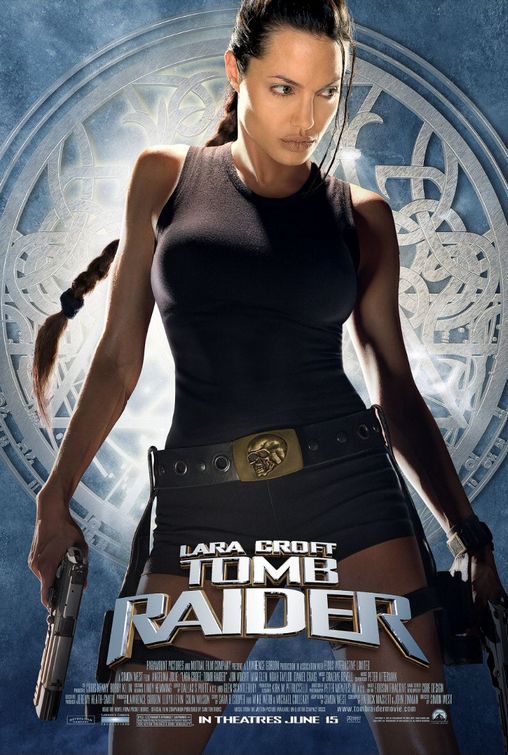
Lara Croft - Feminist icon or object for the 'Male Gaze'?
The character of Lara Croft can be seen as a controversial figure in film. Despite fulfilling the role of a strong and independent individual, her attractive and seductive qualities make this portrayal of a feminist icon questionable. Starting out as a video game, Lara Croft was predominately appreciated by a male audience, which encouraged the same spectators to remain avid fans of the films. However, this sexualised young female is not solely a construction for the male gaze, as she is also admired and respected by a female audience.
Many micro elements help to depict Lara in a way that makes her appeal to a male audience. In the opening scene, we are exposed to a close up of her face, accentuating the beauty in her defining features. This shot is intimate and seductive, and generally one that would only be used on a female character. The camera then crops in from her hips down to her legs, framing her sexual appeal and fragmenting her body.
Lara is one of the very few women shown throughout the film. This lack of female presence heightens Lara’s significance further, making her representative of the female population. This could be seen as a way of either emphasising her importance and dominance, or setting her up as the only sexual object for all the men who surround her, therefore belittling her status. The job of a ‘Tomb Raider’ allows Lara to perform typically masculine tasks and actions, making her enviable and admired by the male characters within the film. Their main purpose is accompanying and assisting Lara as she completes ‘missions’, but the men are also portrayed as spectators of her body. Certain scenes consist of them watching from behind as she walks away, placing the audience in the role of the spectator, looking at her body in a ‘scopophilic’ way.
The short scene in which Lara takes a shower is constructed purely for the satisfaction of a male audience. It is an extreme example of fragmentation of the female body as it frames her body in a visually attractive, sexualised way. The warm, seductive lighting that floods the room coupled with the low, harmonious music helps create the intimate atmosphere that almost accuses the audience of ‘spying’. The camera places the audience behind a thin curtain, which allows us to see the vague outlined image of Lara’s naked body. This also places the spectator in the room with her, forcing them to be subjected to the ‘scopophilic gaze’.
Despite the strength and independence shown though the character of Lara, her weakness is seen through the device of her father. He is the most important man in her life and her emotional side is exemplified only when he is mentioned in the scene. She looks up to him as a dominant male figure, possibly proving her limitation when it comes to men.
Lara Croft presents a contradictory character within the context of the film. She is a powerful female figure who, at the same time, fulfils a voyeuristic, eroticised purpose and ultimately, serves as ‘eye-candy’ for a male audience. It is unclear to say which aspect overrules the other, as both her roles are vital in completing the effect that the film has and what ultimately makes it successful. It could be argued that Croft simply uses her obvious sexual appeal to her advantage with men, in order to fully establish the dominant status she seems to have over them. This is exemplified as at the end of the film as woman triumphs over man, proving the powerful and iconic image that Croft holds, despite also being a object of sexual desire that is subjected to the ‘male gaze’.
The character of Lara Croft can be seen as a controversial figure in film. Despite fulfilling the role of a strong and independent individual, her attractive and seductive qualities make this portrayal of a feminist icon questionable. Starting out as a video game, Lara Croft was predominately appreciated by a male audience, which encouraged the same spectators to remain avid fans of the films. However, this sexualised young female is not solely a construction for the male gaze, as she is also admired and respected by a female audience.
Many micro elements help to depict Lara in a way that makes her appeal to a male audience. In the opening scene, we are exposed to a close up of her face, accentuating the beauty in her defining features. This shot is intimate and seductive, and generally one that would only be used on a female character. The camera then crops in from her hips down to her legs, framing her sexual appeal and fragmenting her body.
Lara is one of the very few women shown throughout the film. This lack of female presence heightens Lara’s significance further, making her representative of the female population. This could be seen as a way of either emphasising her importance and dominance, or setting her up as the only sexual object for all the men who surround her, therefore belittling her status. The job of a ‘Tomb Raider’ allows Lara to perform typically masculine tasks and actions, making her enviable and admired by the male characters within the film. Their main purpose is accompanying and assisting Lara as she completes ‘missions’, but the men are also portrayed as spectators of her body. Certain scenes consist of them watching from behind as she walks away, placing the audience in the role of the spectator, looking at her body in a ‘scopophilic’ way.
The short scene in which Lara takes a shower is constructed purely for the satisfaction of a male audience. It is an extreme example of fragmentation of the female body as it frames her body in a visually attractive, sexualised way. The warm, seductive lighting that floods the room coupled with the low, harmonious music helps create the intimate atmosphere that almost accuses the audience of ‘spying’. The camera places the audience behind a thin curtain, which allows us to see the vague outlined image of Lara’s naked body. This also places the spectator in the room with her, forcing them to be subjected to the ‘scopophilic gaze’.
Despite the strength and independence shown though the character of Lara, her weakness is seen through the device of her father. He is the most important man in her life and her emotional side is exemplified only when he is mentioned in the scene. She looks up to him as a dominant male figure, possibly proving her limitation when it comes to men.
Lara Croft presents a contradictory character within the context of the film. She is a powerful female figure who, at the same time, fulfils a voyeuristic, eroticised purpose and ultimately, serves as ‘eye-candy’ for a male audience. It is unclear to say which aspect overrules the other, as both her roles are vital in completing the effect that the film has and what ultimately makes it successful. It could be argued that Croft simply uses her obvious sexual appeal to her advantage with men, in order to fully establish the dominant status she seems to have over them. This is exemplified as at the end of the film as woman triumphs over man, proving the powerful and iconic image that Croft holds, despite also being a object of sexual desire that is subjected to the ‘male gaze’.





